Numerical Investigation of Flow around Two Tandem Cylinders in the Upper Transition Reynolds Number Regime Using Modal Analysis
Abstract
:1. Introduction
2. Numerical Modeling
2.1. Mathematical Formulation
2.2. Numerical Method
2.3. Computational Domain
- 1.
- A uniform flow was specified at the inlet as:
- 2.
- At the outlet of the domain, the velocities, and were set as zero normal gradient condition and the pressure was set to be zero.
- 3.
- At the top and bottom of the domain, the velocities, the pressure, and were set as zero normal gradient.
- 4.
- A no-slip boundary condition was applied for the velocities on the cylinder surfaces with . A standard wall function was used to resolve the near-wall boundary layer. Therefore, a criterion of with was used, defined as:
2.4. Mesh Convergence and Validation Studies
3. Results
3.1. Hydrodynamic Forces
3.2. Strouhal Number and Flow Structures
3.3. Dynamic Mode Decomposition Analysis
4. Conclusions
- 1.
- With the increasing , flow structures at changed in terms of overshoot, FSR, FR, FSR and bi-stable. This relates to the reattachment point of the separated UC shear layers to the surface of the DC.
- 2.
- The lower vorticity slice of the reattached shear layer to the surface of the DC contributed to the evolution of the positive vorticity behind the DC. It explains the existence of the third super-harmonic for the cases considered. However, the second harmonic observed in the spectra of the lift forces was only for the case of . This relates to assistance of the upper vorticity slice of the reattached shear layer to the development of the negative coherent structure behind the DC.
- 3.
- The values , and were influenced by such that decreased with a decreasing between two cylinders and achieved a negative value for the DC at . The negative value corresponded to a low pressure at the front surface of the DC caused by the cavity flow between UC and DC at . Increasing amplitudes of fluctuation were found at and this relate to FR flow, which causes significant interaction of shear layers. At , the reattachment flow regime (FR) dominated. It creates a longer after-body length of the combined UC and DC body leading to a sudden reduction of the value.
- 4.
- The SPDMD algorithm was used to extract a few dominant modes which contributed the most to the flow dynamics. It was found that Mode 2 for and did not contribute to the lift force. Therefore, there was no peak in the frequency spectra of the lift force at the second harmonic of for these two cases, although Mode 2 was identified by using SPDMD. In addition, the reduced-order representations of the flow field, which consist of the finite SPDMD modes number, can correctly reconstruct the wake flow at the investigated high Reynolds number.
Author Contributions
Funding
Institutional Review Board Statement
Informed Consent Statement
Data Availability Statement
Conflicts of Interest
References
- Sumer, B.; Fredsøe, J. Hydrodynamics around Cylindrical Structures; World Scientific Publishing Co., Pte. Ltd.: Singapore, 1997. [Google Scholar]
- Ong, M.C.; Utnes, T. Numerical simulation of flow around a smooth circular cylinder at very high Reynolds numbers. J. Mar. Struct. 2009, 22, 142–153. [Google Scholar] [CrossRef]
- Nakaguchi, H.; Hashimoto, K.; Muto, S. An experimental study on aero-dynamic drag of rectangular cylinders. J. Jpn. Soc. Aerospace Sci. 1968, 16, 1–5. [Google Scholar]
- Norberg, C. Flow around rectangular cylinders: Pressure forces and wake frequencies. J. Wind Eng. Ind. Aerodyn. 1993, 49, 187–196. [Google Scholar] [CrossRef]
- Ohya, Y. Note on a discontinuous change in wake pattern for a rectangular cylinder. J. Fluids Struct. 1994, 8, 325–330. [Google Scholar] [CrossRef]
- Okajima, A. Numerical simulation of flow around rectangular cylinders. J. Wind Eng. Ind. Aerodyn. 1990, 33, 171–180. [Google Scholar] [CrossRef]
- Tian, X.; Ong, M.C.; Yang, J.; Myrhaug, D. Unsteady RANS simulations of flow around rectangular cylinders with different aspect ratios. J. Ocean Eng. 2013, 58, 208–216. [Google Scholar] [CrossRef]
- Dutta, S.; Panigrahi, P.K.; Muralidhar, K. Experimental investigation of flow past a square cylinder at an angle of incidence. J. Eng. Mech. 2008, 134, 788–803. [Google Scholar] [CrossRef]
- El-Sherbiny, S. Flow separation and reattachment over the sides of a 90° triangular prism. J. Wind Eng. Ind. Aerodyn. 1983, 11, 393–403. [Google Scholar] [CrossRef]
- Nakagawa, T. Vortex shedding mechanism from a triangular prism in a subsonic flow. J. Fluid Dyn. Res. 1989, 5, 69–81. [Google Scholar] [CrossRef]
- Cheng, M.; Liu, G.R. Effects of afterbody shape on flow around prismatic cylinders. J. Wind Eng. Ind. Aerodyn. 2000, 84, 181–196. [Google Scholar] [CrossRef]
- Tritton, D. Experiments on the Flow past a circular cylinder al low Reynolds numbers. J. Fluid Mech. 1959, 6, 547–567. [Google Scholar] [CrossRef]
- Dimopoulos, H.; Hanratty, T. Velocity gradients at the wall for flow around a cylinder for Reynolds numbers between 60 and 360. J. Fluid Mech. 2006, 33, 303–319. [Google Scholar] [CrossRef]
- Park, J.; Kwon, K. Numerical solutions of flow past a circular cylinder at Reynolds numbers up to 160. KSME Int. J. 1998, 12, 1200–1205. [Google Scholar] [CrossRef]
- Rajani, B.; Kandasamy, A. Numerical simulation of laminar flow past a circular cylinder. J. Appl. Math. Medel. 2009, 33, 1225–1247. [Google Scholar] [CrossRef]
- Zdravkovich, M. Review of flow interference between two circular cylinders in various arrangements. J. Fluids 1977, 99, 618–663. [Google Scholar] [CrossRef]
- Sumner, D. Two circular cylinders in cross-flow: A review. J. Fluid Struct. 2010, 26, 849–899. [Google Scholar] [CrossRef]
- Zdravkovich, M. The effects of interference between circular cylinders in cross flow. J. Fluids 1978, 1, 239–261. [Google Scholar] [CrossRef]
- Hori, E. Experiments on flow around a pair of parallel circular cylinders. In Proceedings of the Ninth Japan National Congress for Applied Mechanics, Nagoya, Tokyo, 29 August–1 September 1959; Volume 11, pp. 231–234. [Google Scholar]
- Huhe-Aode; Tatsuno, M. Visual studies of wake structure behind two cylinders in tandem arrangement. Rep. Res. Inst. Appl. Mech. 1985, 32, 1–20. [Google Scholar]
- Nishimura, T.; Ohori, Y.; Kawamura, Y. Flow pattern and rate of mass transfer around two cylinders in tandem. J. Intern. Chem. Engin. 1986, 26, 123–129. [Google Scholar]
- Xu, G.; Zhou, Y. Strouhal numbers in the wake of two inline cylinders. J. Exp. Fluids 2004, 37, 248–256. [Google Scholar] [CrossRef]
- Alam, A. Two interacting cylinders in cross flow. J. Phys. Rev. E 2011, 84, 639–654. [Google Scholar] [CrossRef] [PubMed] [Green Version]
- Catalano, P.; Wang, M.; Iaccarino, G.; Moin, P. Numerical simulation of the flow around a circular cylinder at high Reynolds numbers. Int. J. Heat Fluid Flow 2003, 24, 463–469. [Google Scholar] [CrossRef]
- Hu, X.; Zhang, X.; You, Y. On the flow around two circular cylinders in tandem arrangement at high Reynolds number. J. Ocean Eng. 2019, 189, 106–301. [Google Scholar] [CrossRef]
- Schmid, P. Dynamic Mode Decomposition of numerical and experimental data. J. Fluid Mech. 2010, 656, 5–28. [Google Scholar] [CrossRef] [Green Version]
- Rowley, C.; Mezić, I.; Bagheri, S.; Schlatter, P.; Henningson, D.S. Spectral analysis of nonlinear flows. J. Fluid Mech. 2009, 22, 142–153. [Google Scholar] [CrossRef] [Green Version]
- Taira, K.; Brunton, S.L.; Dawson, S.T.; Rowley, C.W.; Colonius, T.; McKeon, B.J. Modal analysis of fluid flows: An overview. AIAA J. 2017, 55, 4013–4041. [Google Scholar] [CrossRef] [Green Version]
- Bagheri, S. Koopman-mode decomposition of the cylinder wake. J. Fluid Mech. 2013, 725, 596–623. [Google Scholar] [CrossRef]
- Hemati, M.S.; Rowley, C.W.; Deem, E.A.; Cattafesta, L.N. De-biasing the dynamic mode decomposition for applied Koopman spectral analysis of noisy datasets. Theor. Comput. Fluid Dyn. 2017, 31, 349–368. [Google Scholar] [CrossRef] [Green Version]
- Schmid, P.; Li, L.; Pust, O. Application of the dynamic mode decomposition. Theor. Comput. Fluid Dyn. 2011, 25, 249–259. [Google Scholar] [CrossRef]
- Menter, F.; Kuntz, M.; Langtry, R. Ten years of industrial experience with the SST turbulence model. J. Heat Mass Transf. 2003, 4, 625–632. [Google Scholar]
- Porteous, A.; Habbit, R.; Colmenares, J.; Poroseva, S.; Murman, S.M. Simulations of incompressible separated turbulent flows around two-dimensional bodies with URANS models in OpenFOAM. In Proceedings of the 22nd AIAA Computational Fluid Dynamics Conference 2015, Dallas, TX, USA, 22–26 June 2015. [Google Scholar]
- Pang, A.; Skote, M.; Lim, S.Y. Modelling high re flow around a 2D cylindrical bluff body using the k-ω (SST) turbulence model. J. Prog. Comput. Fluid Dyn. 2016, 16, 48–57. [Google Scholar] [CrossRef]
- Janocha, M. Numerical simulations of flow-induced vibrations of two rigidly coupled cylinders with uneven diameters in the upper transition Reynolds number regime. J. Mar. Struct. 2021, 105, 103–332. [Google Scholar]
- Jones, G.; Cincotta, J. Aerodynamic Forces on a Stationary and Oscillating Circular Cylinder at High Reunolds Numbers; Technical Report TB R-300; NASA: Washington, DC, USA, 1969.
- Shih, W.C.L.; Wang, C. Experiments on flow past rough circular cylinders at large Reynolds numbers. J. Wind Eng. Aerodyn. 1993, 49, 351–368. [Google Scholar] [CrossRef]
- Schmidt, L. Fluctuating Forcemeasurements upon a Circular Cylinder at Reynolds Number up to 5 × 106; Technical Report; Langley Research Center: Hampton, VA, USA, 1996. [Google Scholar]
- Meyer, J.; Alam, M.M. Reynolds number effect on flow-induced forces on two tandem cylinders. In Proceedings of the International Conference on Mechanical Engineering, Dhaka, Bangladesh, 18–20 December 2011. [Google Scholar]
- Jovanović, M.R.; Schmid, P.J.; Nichols, J.W. Sparsity-promoting dynamic mode decomposition. Phys. Fluids 2014, 26, 024103. [Google Scholar] [CrossRef] [Green Version]
- Yin, G.; Ong, M.C. On the wake flow behind a sphere in a pipe flow at low Reynolds numbers. Phys. Fluids 2020, 32, 103605. [Google Scholar] [CrossRef]
- Yin, G.; Ong, M.C. Numerical analysis on flow around a wall-mounted square structure using Dynamic Mode Decomposition. J. Ocean Eng. 2021, 223, 108–647. [Google Scholar] [CrossRef]
- Pan, C.; Xue, D. On the accuracy of dynamic mode decomposition in estimating instability of wave packet. Exp. Fluid 2015, 56, 164. [Google Scholar] [CrossRef]
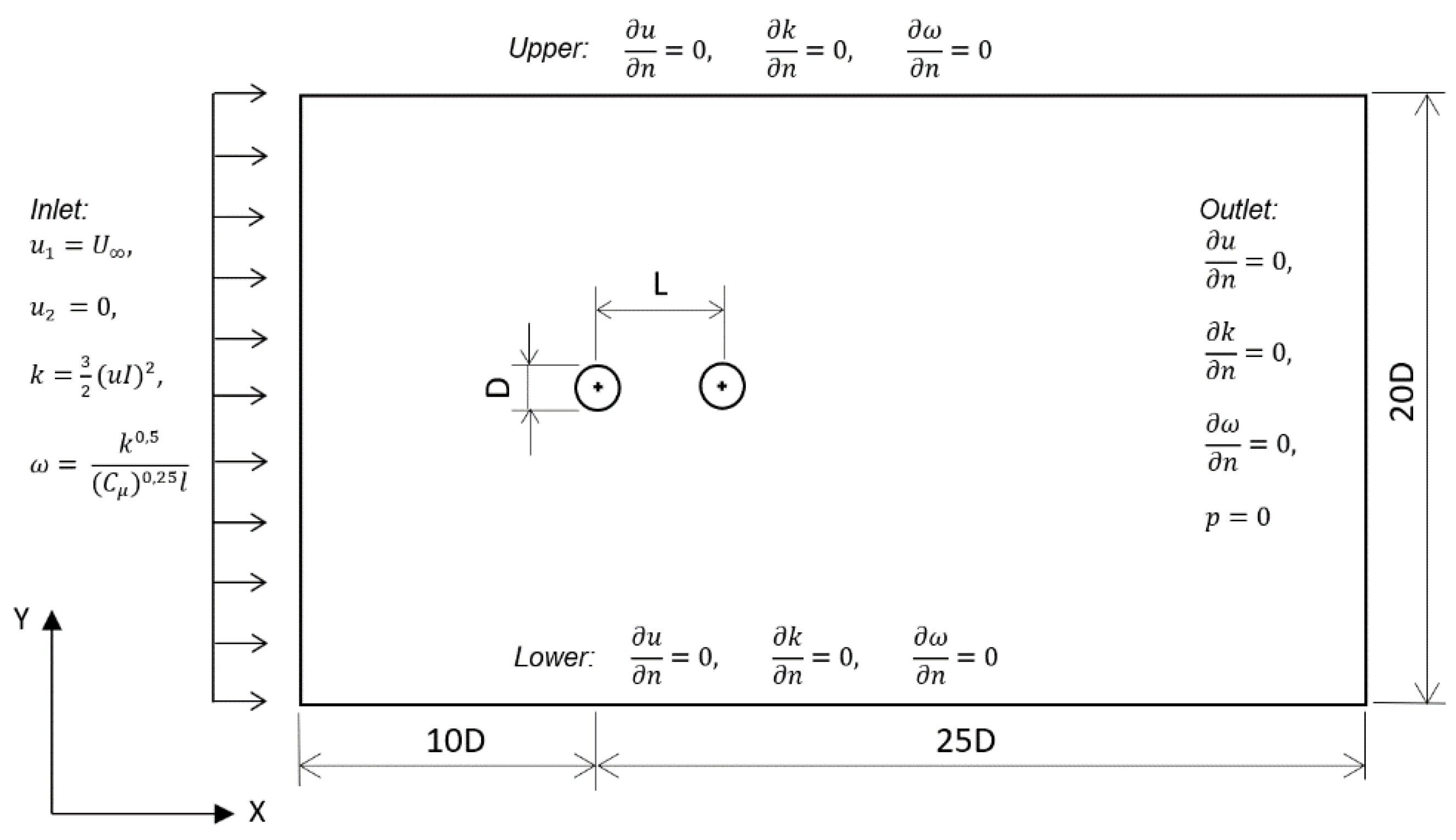
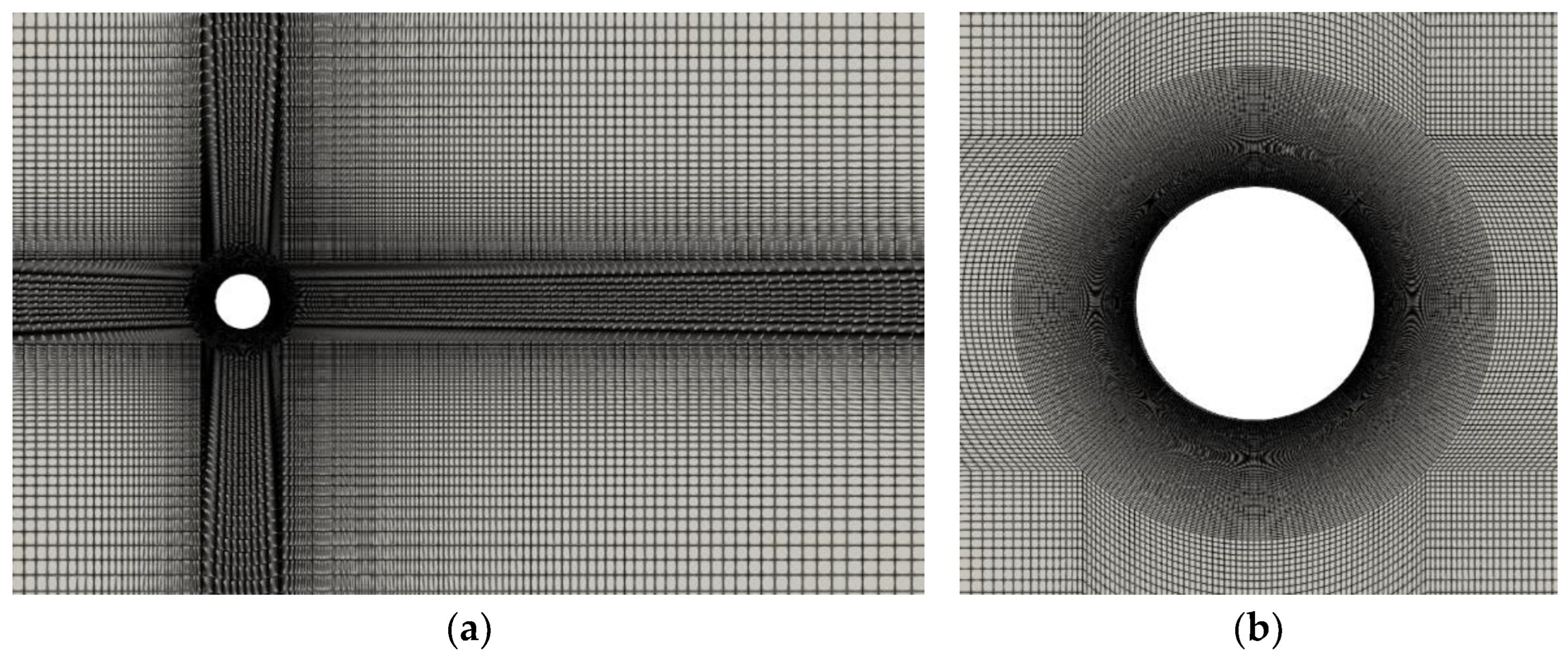

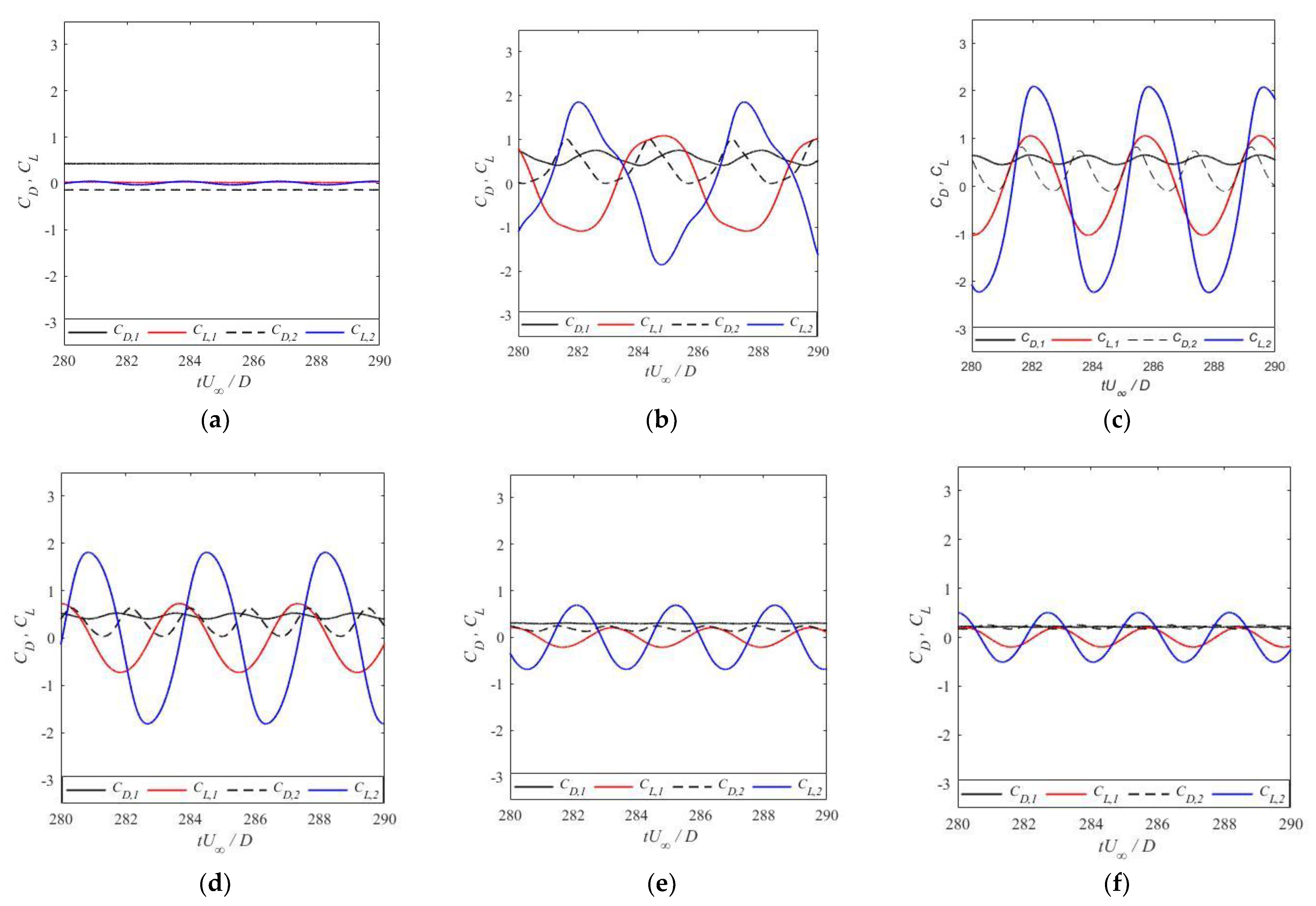


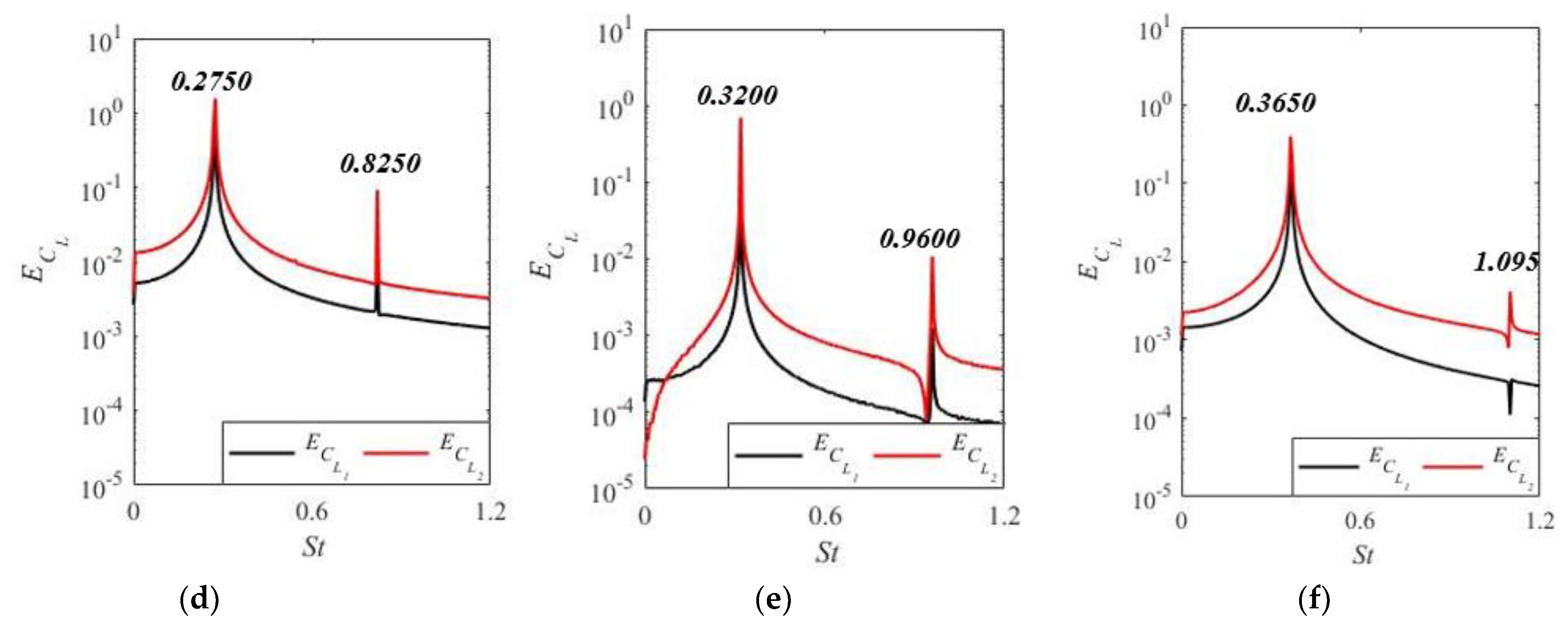
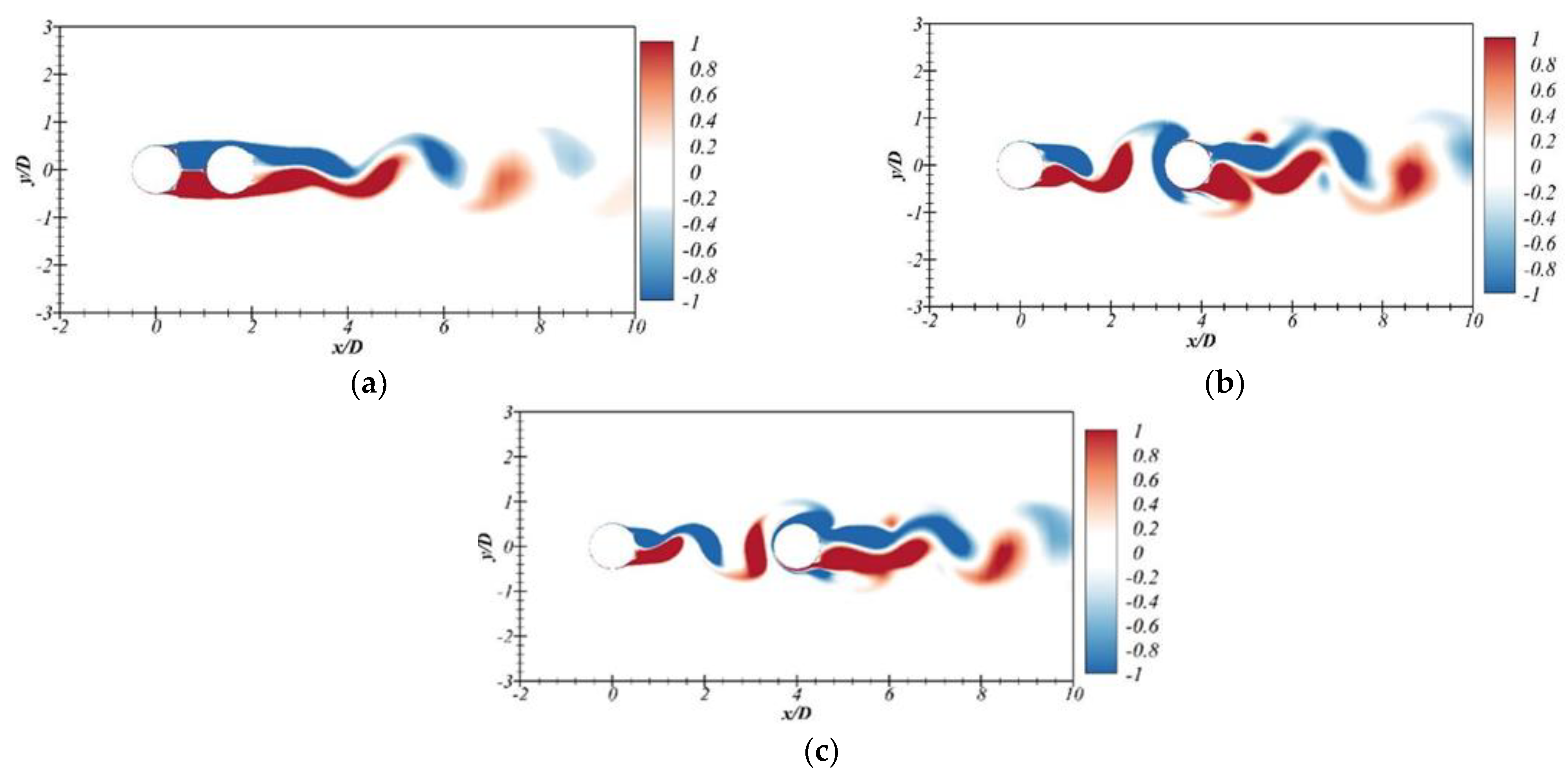
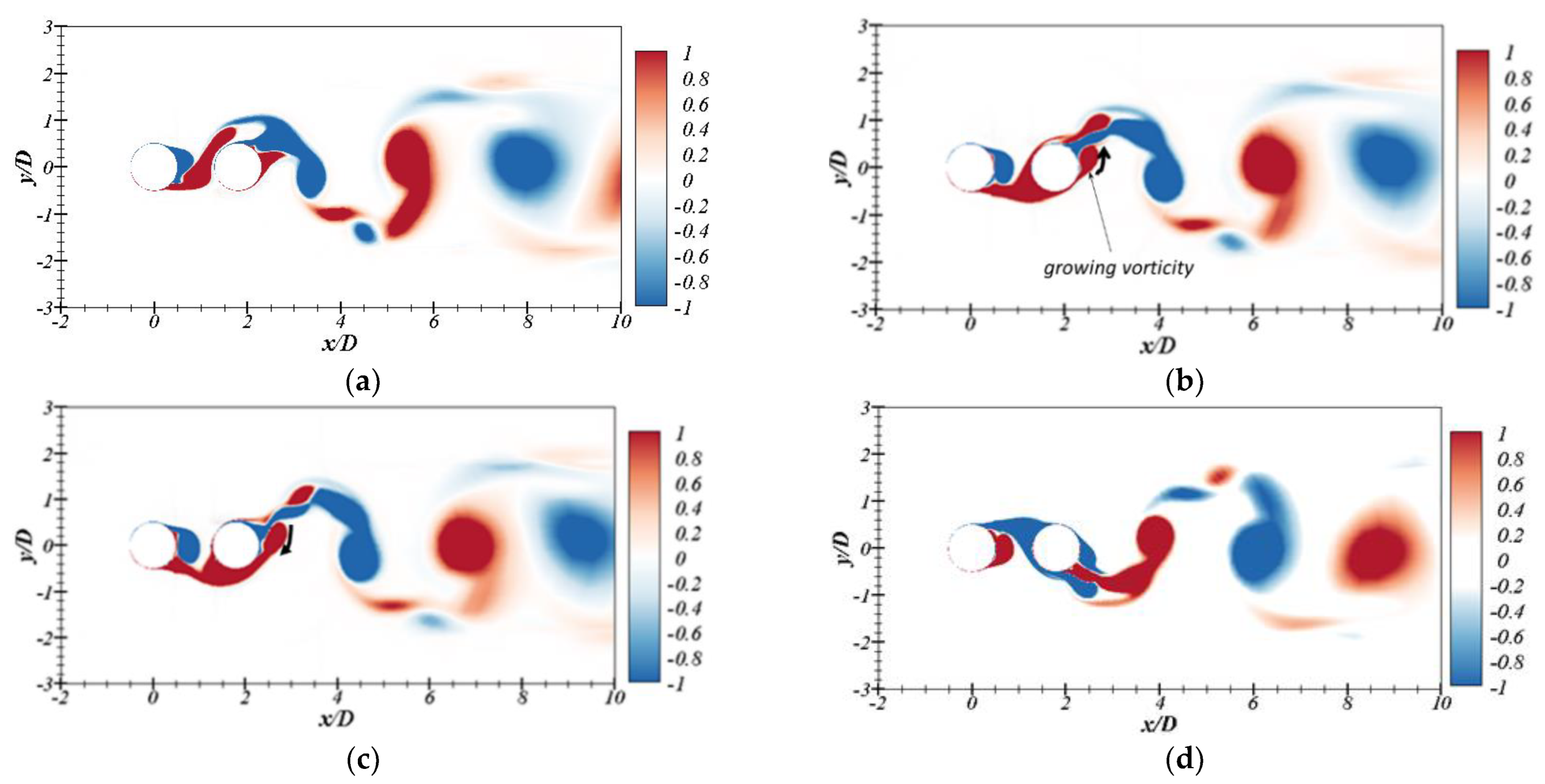

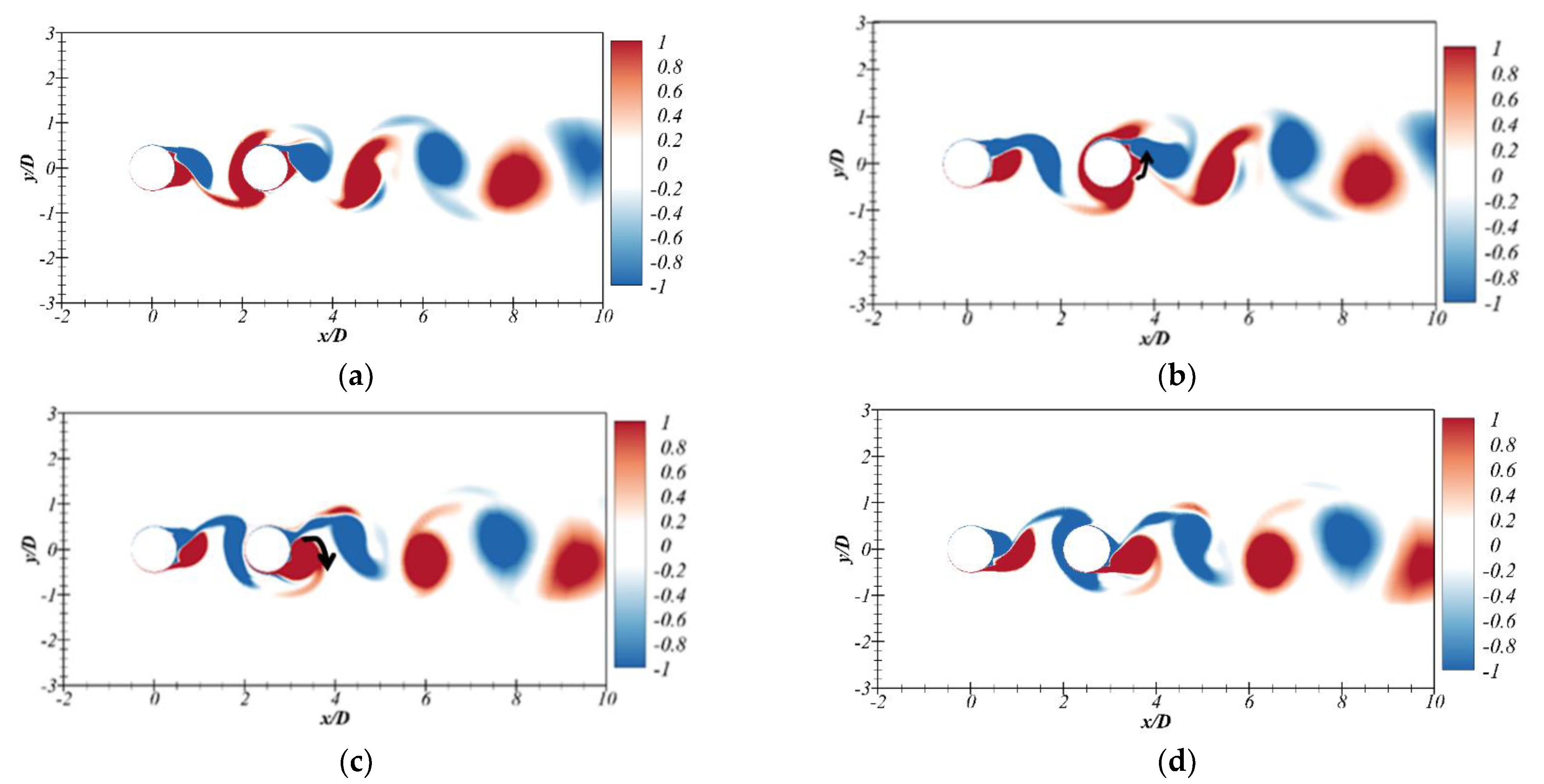




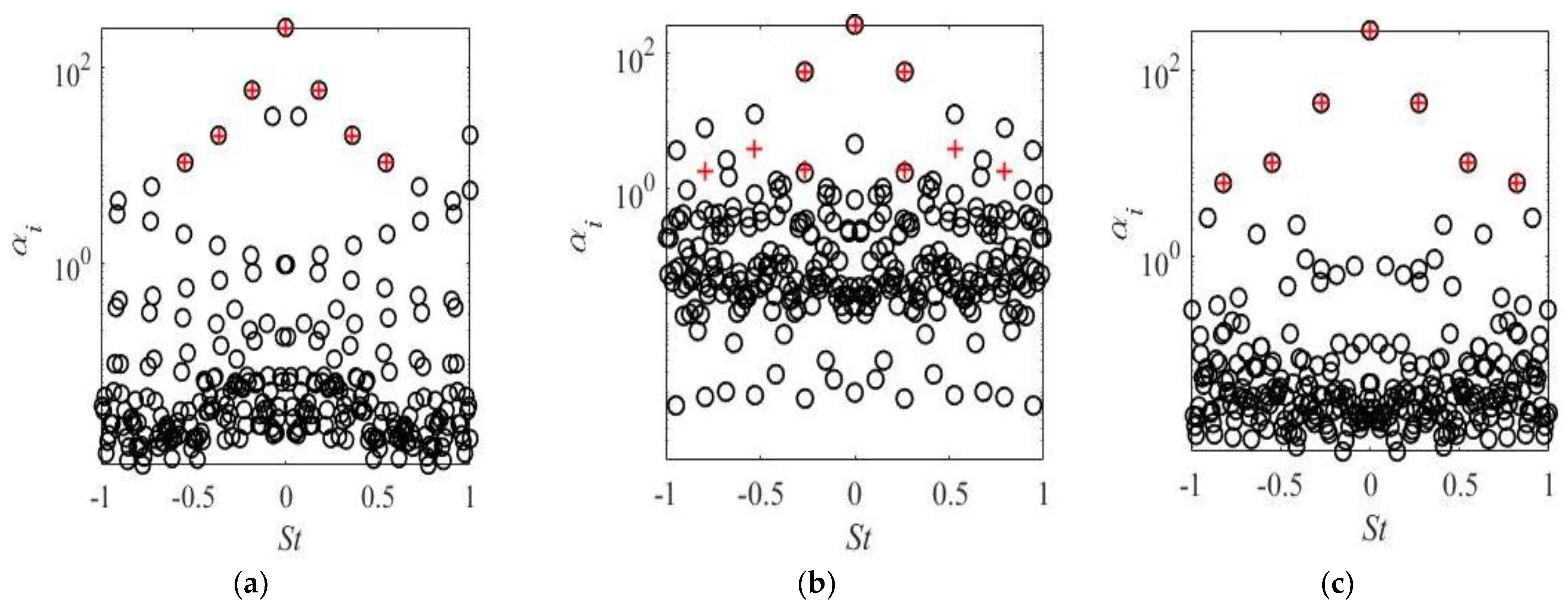

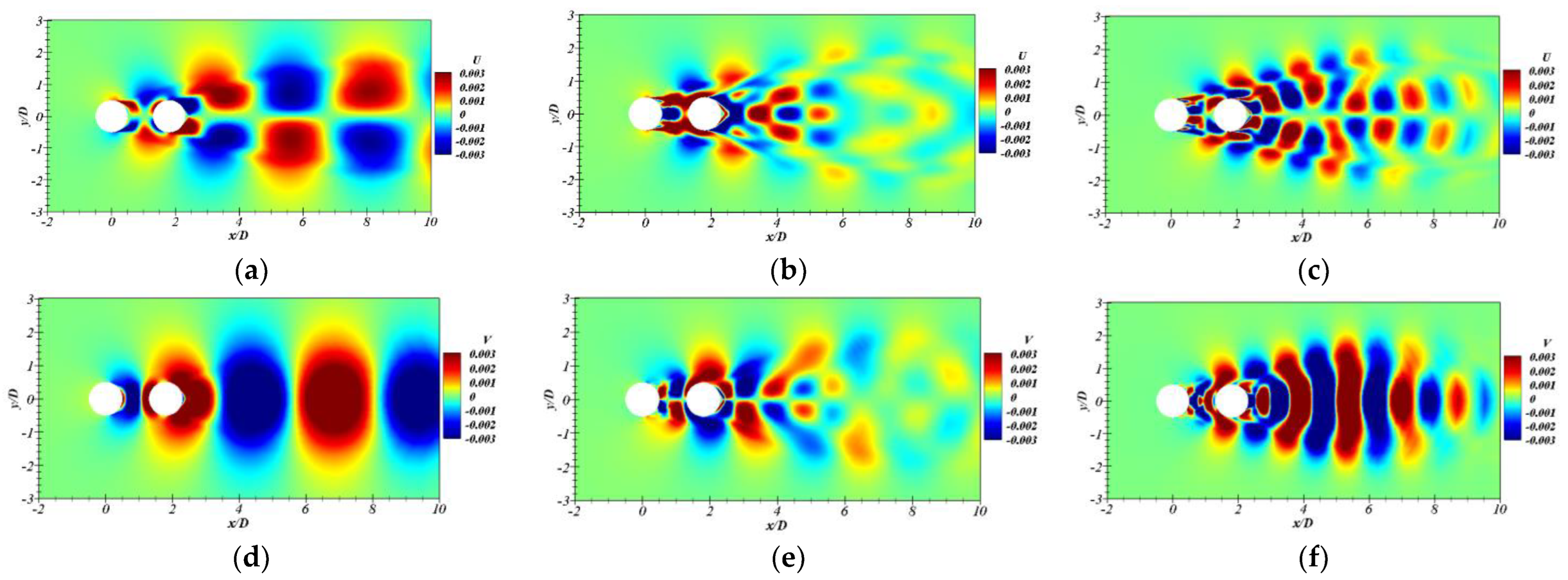


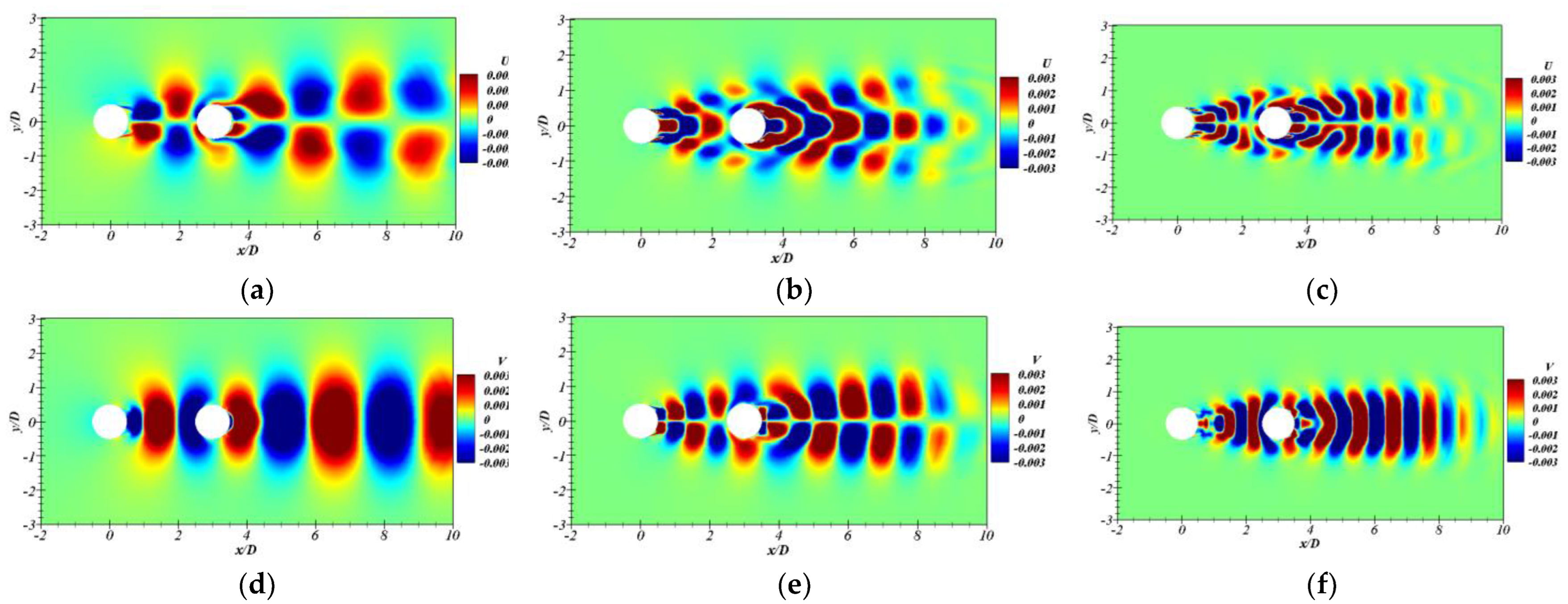


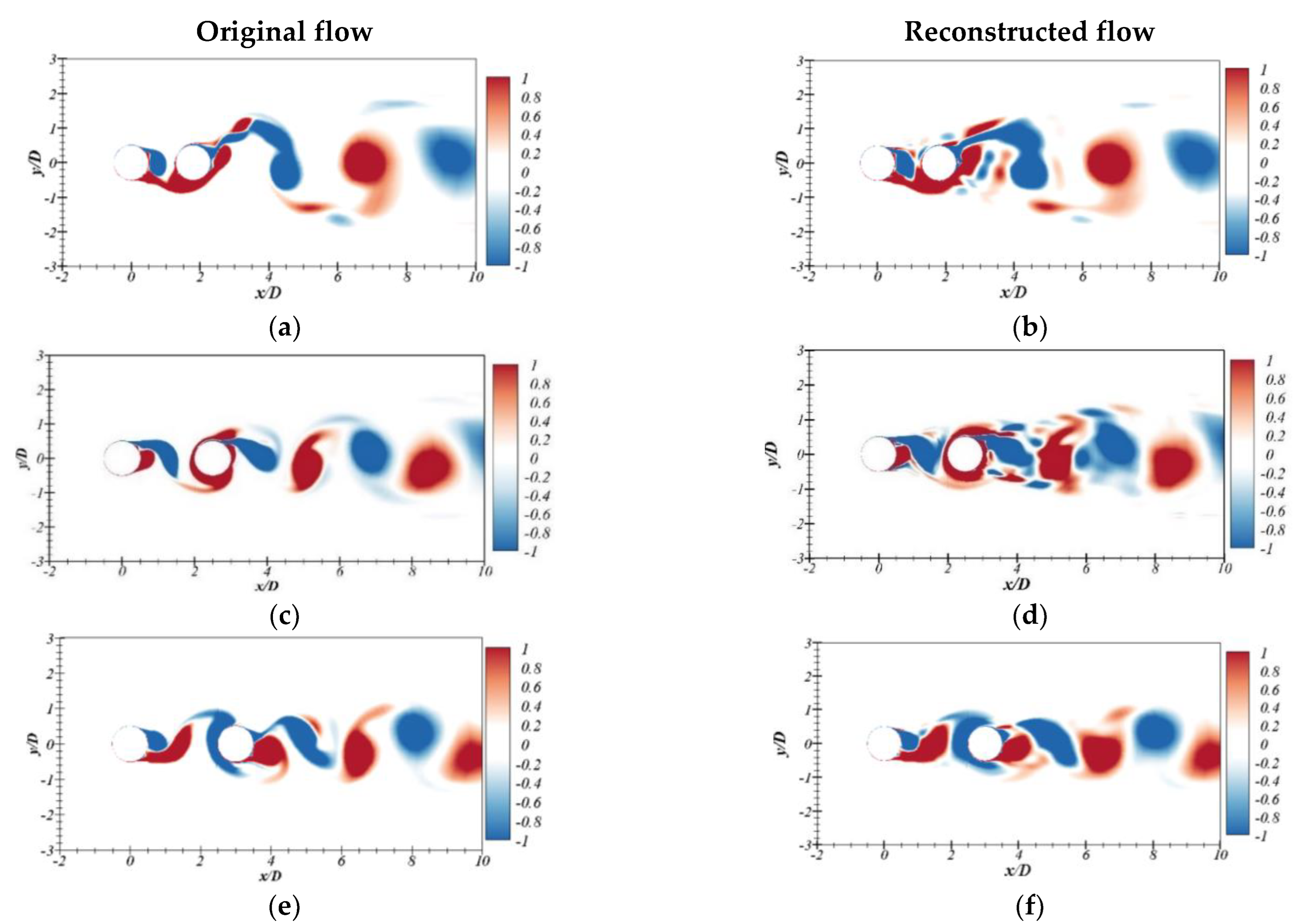


| Case | No. of Cells | |||
|---|---|---|---|---|
| M1 | 74,496 | 0.4657 | 0.1565 | 0.3227 |
| M2 | 113,256 | 0.4706 | 0.1599 | 0.3293 |
| M3 | 171,970 | 0.4639 | 0.1553 | 0.3221 |
| Source/Author | Method | St | |||
|---|---|---|---|---|---|
| Present study | 2D URANS | 0.4706 | 0.1599 | 0.3293 | |
| Ong et al. (2009) [2] | 2D URANS | 0.4573 | 0.0766 | 0.3052 | |
| Porteous et al. (2015) [33] | 2D URANS | 0.4206 | - | 0.1480 | |
| Pang et al. (2016) [34] | 2D URANS | 0.4570 | 0.1847 | 0.3210 | |
| Janocha et al. (2021) [35] | 2D URANS | 0.4616 | 0.1750 | 0.3204 | |
| Jones et al. (1969) [36] | Experiments | 0.15–0.54 | - | - | |
| Shih et al. (1993) [37] | Experiments | 0.16–0.50 | - | - | |
| Schmidt (1996) [38] | Experiments | 0.18–0.53 | - | - |
| UC | DC | UC | DC | |
|---|---|---|---|---|
| 1.56 | 0.0271 | 0.0283 | 0.4279 | −0.1376 |
| 1.8 | 0.8352 | 1.1848 | 0.5845 | 0.3969 |
| 2.5 | 0.7512 | 1.5898 | 0.5456 | 0.2740 |
| 3 | 0.5234 | 1.3160 | 0.4707 | 0.3106 |
| 3.7 | 0.1447 | 0.4911 | 0.3031 | 0.1875 |
| 4 | 0.1394 | 0.3580 | 0.2169 | 0.2120 |
| Flow Regime | |||
|---|---|---|---|
| UC | DC | ||
| 1.56 | 0.3357 | 0.3357 | Overshoot |
| 1.8 | 0.1800 | 0.1800 | FSR |
| 2.5 | 0.2650 | 0.2650 | FR |
| 3 | 0.2750 | 0.2750 | FSR |
| 3.7 | 0.3200 | 0.3200 | Bi-stable |
| 4 | 0.3650 | 0.3650 | Bi-stable |
| Mode 1 | Mode 2 | Mode 3 | |
|---|---|---|---|
| Cumulative Energy, % | |||
| 1.8 | 85.70 | 92.85 | 95.35 |
| 2.5 | 87.10 | 93.55 | 94.02 |
| 3 | 93.60 | 96.33 | 98.17 |
Publisher’s Note: MDPI stays neutral with regard to jurisdictional claims in published maps and institutional affiliations. |
© 2022 by the authors. Licensee MDPI, Basel, Switzerland. This article is an open access article distributed under the terms and conditions of the Creative Commons Attribution (CC BY) license (https://creativecommons.org/licenses/by/4.0/).
Share and Cite
Nazvanova, A.; Yin, G.; Ong, M.C. Numerical Investigation of Flow around Two Tandem Cylinders in the Upper Transition Reynolds Number Regime Using Modal Analysis. J. Mar. Sci. Eng. 2022, 10, 1501. https://doi.org/10.3390/jmse10101501
Nazvanova A, Yin G, Ong MC. Numerical Investigation of Flow around Two Tandem Cylinders in the Upper Transition Reynolds Number Regime Using Modal Analysis. Journal of Marine Science and Engineering. 2022; 10(10):1501. https://doi.org/10.3390/jmse10101501
Chicago/Turabian StyleNazvanova, Anastasiia, Guang Yin, and Muk Chen Ong. 2022. "Numerical Investigation of Flow around Two Tandem Cylinders in the Upper Transition Reynolds Number Regime Using Modal Analysis" Journal of Marine Science and Engineering 10, no. 10: 1501. https://doi.org/10.3390/jmse10101501
APA StyleNazvanova, A., Yin, G., & Ong, M. C. (2022). Numerical Investigation of Flow around Two Tandem Cylinders in the Upper Transition Reynolds Number Regime Using Modal Analysis. Journal of Marine Science and Engineering, 10(10), 1501. https://doi.org/10.3390/jmse10101501








